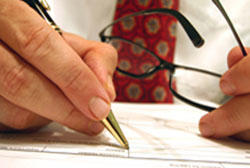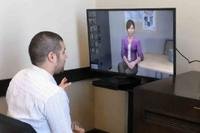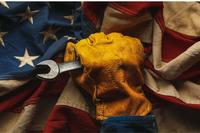According to one UCLA study, people evaluate one another using the "Three Vs": visual (appearance), vocal (voice) and verbal (what you say). About 93% of whether communication is effective is determined by nonverbal signals.
Another study, conducted by a University of Toledo psychology professor, concluded that the first 30 seconds make or break the connection between two people when they meet for the first time. So the next time you're on an interview, keep in mind that the interviewer may be drawing conclusions about you before you've even gotten to the real interview.
Take a look at these worst- and best-case scenarios:
Worst Case
Jack is nervous about his interview as he sits in the lobby. Anyone watching can see the signs: His foot is tapping rapidly, and he's muttering to himself, obviously rehearsing his lines. He's slouched down in his chair, and when he spots the interviewer coming down the hall, he begins to wipe a sweaty hand on his pant leg.
He stands, and as he does, the magazine on his lap falls to the floor. When he bends to pick it up, he knocks over his portfolio and papers fall out. The interviewer is thinking, "This guy is a basket case. He doesn't look like the kind of person we want representing our product line."
When Jack finally pulls himself together, he holds out his hand, but his handshake is weak. Jack's fate may be sealed before he answers his first question.
Best Case
Joann feels prepared and confident as she waits in the lobby for her interviewer. She knows she looks good, and she feels good. She has practiced and prepared and knows she can do this job. She'll concentrate on selling herself as the solution to the employer's problems. As her interviewer approaches, she stands and continues to smile, looking directly at him. She looks him in the eye as she extends her hand. She gives a firm shake and smiles. "This is a very confident woman -- someone who shows real promise," thinks the interviewer. The first impression has been made, and it is a positive one.
The Drill
The following seven steps, or "two-minute drill," will guide you toward a best-case interview scenario.
* Appearance counts. When you look good, you feel good. Make sure you look groomed and neat. If you were a book, would someone want to read more?
* Your clothes and accessories should be conservative and neutral rather than wild and loud. Your clothes are your packaging and should not take attention away from the product.
* Nonverbal communication sometimes conveys a stronger message than words. When you slouch, whether sitting or standing, you're saying volumes about you and your confidence level. Sit up straight -- like your mother always told you to. When you stand, make yourself as tall as possible: shoulders back and head held high.
* Eye contact and smiles can indicate a confident and upbeat attitude. You will notice that many job postings ask for enthusiasm and energy. This is a good opportunity to demonstrate your social and interpersonal skills as well as your excitement about the opportunity for which you're interviewing.
* The handshake sends a strong tactile message. Whether your hands are hot and sweaty or cold and clammy, you can try some tricks to control the temperature. To cool your hands, try running cold water on the insides of your wrists. Use hot water if your hands are cool. If you have particularly sweaty hands, try using a deodorant gel (antiperspirant) as a lotion.
* Your voice and the volume of your speech convey a strong impression. Whether the interview is over the phone or face to face, you should speak with enthusiasm and energy. Use a firm voice to demonstrate confidence.
* Your vocabulary reveals your communication skills and ability to interact with people, especially ones you've not met before. The words you choose when answering interview questions will say something about you as well as your knowledge of the industry. It is important to use their words and talk their talk.
Want to Know More About the Military?
Be sure to get the latest news about the U.S. military, as well as critical info about how to join and all the benefits of service. Subscribe to Military.com and receive customized updates delivered straight to your inbox.











